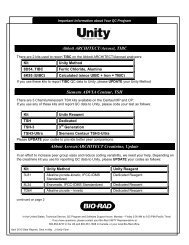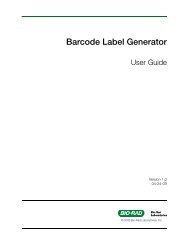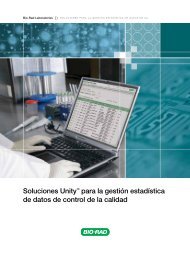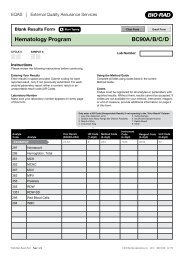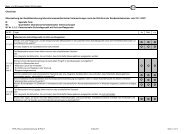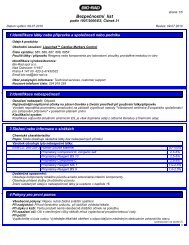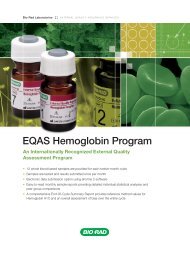EQAS Program User Guide - QCNet
EQAS Program User Guide - QCNet
EQAS Program User Guide - QCNet
You also want an ePaper? Increase the reach of your titles
YUMPU automatically turns print PDFs into web optimized ePapers that Google loves.
Chapter 5: <strong>EQAS</strong> Reports2Analyte SummaryThis section shows the peer group applicable to your instrument/reagent and the unit for the analyte’sreported Lab Results, Comparator Means, and Reference Values.• Batch #The samples are grouped by batch. A batch typically consists of three samples (replicates) with thesame concentration.• Sample #Sample numbers associated to the batch are listed in ascending order. The example above showssamples 4, 7, and 10 are the samples in Batch 1.• Lab ResultSample results associated with each of the indicated sample numbers are presented. It is possiblethat results that were previously within acceptable limits in the Sample Report are now flagged in theEnd-of-Cycle Report or vice versa. Exceptions associated with the sample are shown. Since onlyone exception can be shown, a late exception takes precedence over other exceptions (such as 2.0 Z-score).• Comparator MeanRobust mean of the comparator for the given sample is estimated. The symbol appears if therewas a non-robust calculation of the sample comparator mean.• ComparatorThe comparator level for each sample is noted for your lab.• Your Lab Z-score:Important: This comparator can be different from that in the original Sample Report, asthe End-of-Cycle Report reflects the recalculated statistics with all participants’ late andamended data included in the data set. The recalculated Z-score is given for eachsample result.Your result – Comparator meanComparator SD60 <strong>EQAS</strong> <strong>Program</strong> <strong>User</strong> <strong>Guide</strong>






